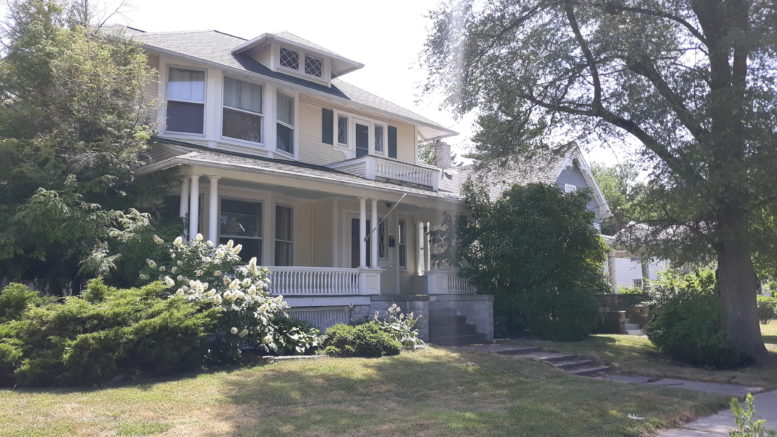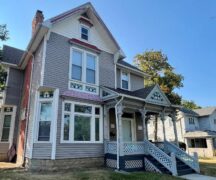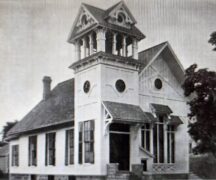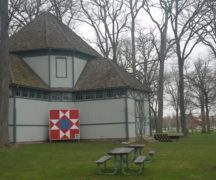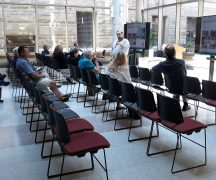By JAN LARSON McLAUGHLIN
BG Independent News
Bowling Green’s effort to preserve the community’s historic buildings has reached a landmark.
More than a decade after efforts began to preserve Bowling Green’s historic buildings, the first home has been submitted for the designation.
The grand yellow house, built in 1892 at 328 E. Court St., was home to Dr. Willis Maynard Tuller, who was elected as Bowling Green’s mayor in 1885 and as director of the school board in 1883.
Tuller was an original member of the BG Natural Gas Co., which was organized in 1885 to provide gas for illuminating and fuel purposes in the city. Tuller also served as the physician and surgeon for both railroads that passed through Bowling Green.
Other structures – such as the city’s Police Building, Needle Hall in City Park, and the Wood County Courthouse – have already achieved local historic designations. And efforts are underway to include University Hall at Bowling Green State University to the roster.
But the application for the historic home was long-awaited. And the preservation commission members hope others with historic homes will follow.
“This is our first one that is owner-initiated,” said Bowling Green Planning Director Heather Sayler. The current owner, Nina Vaughan, sees the designation as a way to help preserve the home, Sayler said.
“She is absolutely in love with that house and the history, and is really excited about this,” Sayler said. “She said ‘It’s 130 years old, and I want it to stay another 130 years plus and outlive me.’”
“I’m just really happy she wants to do this,” Sayler said.
The house still has its original woodwork, brass doorknobs, pocket books, old sink, and old coal entrance. The exterior boasts hipped dormers with lattice windows.
“I think the house definitely deserves to be recognized,” said Wil Roudebush, member of the city’s Historic Preservation Commission.
“It retains a lot of that historical integrity on the exterior,” said commission member Chris Mowen. “I definitely think it qualifies based on our ordinance.”
A structure must meet at least two of 11 historic designation criteria to qualify for the designation. Mowen said the East Court Street home meets several criteria including:
- Being at least 50 years old.
- Possesses historic significance.
- Identifies with a person or group of people who influenced society.
- Exemplifies the cultural, economic, social, political or historic heritage of the city or surrounding areas.
- Embodies the distinctive characteristics of an architectural type, period or method of construction.
- Has a unique location or singular physical characteristics represent a familiar visual feature of a neighborhood or city.
The next step in the process will be a public hearing held later this month by the Historic Preservation Commission, which will make a recommendation on the application to City Council. The application then goes to the city planning commission, then returns to City Council for a public hearing.
The decade delay between initial discussions about historic preservation and the application for the East Court Street house occurred after complaints from large landowners stalled the efforts.
However, the historic preservation plan was resurrected a couple years ago, and focused on debunking the myths that resulted in its initial demise.
The goal of the historic preservation plan is to help the city and property owners retain historically significant structures. It is hoped the ordinance will slow the cultural decline experienced in the older housing stock in the last few decades.
Some historic homes are losing the battle against time and rental transformation. The plan would require property owners in designated historic districts to meet standards when making substantive changes to the exterior of buildings. There would be no rules for the interior of structures.
The effort is focused on protecting the historic integrity of buildings – and helping when possible with restorations. It is not to nitpick and tell homeowners what they can and cannot do with their properties, commission members have stressed.
To function fully, the city applied to become a Certified Local Government through the Ohio Historic Preservation Office. The CLG status allows the city to get preservation grants and tax credits to help homeowners and businesses protect historic buildings.
The commission’s goal is to “preserve, promote, encourage and support the maintenance, use and reuse of historic buildings in the city.” Its intent is to help property owners who want to preserve historic structures.
It is expected that multiple historic overlay zoning districts will be created in the city – if the majority of the property owners in the areas support the idea.

